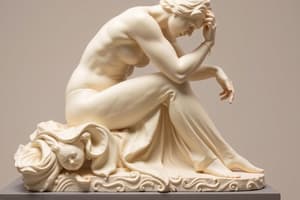Podcast
Questions and Answers
¿Quién fundó el movimiento futurista en Italia en 1909?
¿Quién fundó el movimiento futurista en Italia en 1909?
- Leonardo da Vinci
- Pablo Picasso
- Vincent van Gogh
- Filippo Tommaso Marinetti (correct)
¿Cuál de los siguientes movimientos artísticos se caracterizó por rechazar la lógica y la razón?
¿Cuál de los siguientes movimientos artísticos se caracterizó por rechazar la lógica y la razón?
- Dadaísmo (correct)
- Bauhaus
- Expresionismo
- Futurismo
¿Qué aspecto destacado del Expresionismo alemán se centraba en emociones intensas y sentimientos internos?
¿Qué aspecto destacado del Expresionismo alemán se centraba en emociones intensas y sentimientos internos?
- Búsqueda de la perfección estética
- Representación de la realidad objetiva
- Uso de colores brillantes (correct)
- Énfasis en la lógica y la razón
¿Qué característica principal definía al movimiento Bauhaus?
¿Qué característica principal definía al movimiento Bauhaus?
¿Qué elemento predominante inspiraba a los poetas futuristas para componer su poesía de forma 'discontinua'?
¿Qué elemento predominante inspiraba a los poetas futuristas para componer su poesía de forma 'discontinua'?
¿Cuál era el objetivo principal de los artistas dadaístas en su obra visual, literaria y musical?
¿Cuál era el objetivo principal de los artistas dadaístas en su obra visual, literaria y musical?
Flashcards are hidden until you start studying
Study Notes
Artistic Avant-Gardes of the Early 20th Century
The early 20th century was a period of great artistic experimentation and innovation, with several movements known as the artistic avant-garde challenging traditional art forms and pushing boundaries. This article will explore four key movements within this context: Futurism, Dadaism, Expressionism, and Bauhaus.
Futurism
Futurism was an Italian movement founded by Filippo Tommaso Marinetti in 1909. It emphasized speed, violence, technology, and the machine. Poets were encouraged to compose 'discontinuous' poetry based on the model of the modern city.
Dadaism
Dada emerged during World War I in Europe. It is considered to be a non-aesthetic, anti-intellectual, and anti-traditional movement which rejected logic and reason. Dada artists sought to liberate themselves from the destructive insanity of war through irreverent and often absurd creativity. They embraced the concept of chaos and contradiction in their visual arts, literature, music, theater, and film.
Expressionism
Expressionism developed in Germany around 1880. This movement focused on intense emotions, inner feelings, and subjectivity rather than objective reality. Expressionist painters tried to create an emotional response in their audience, using bold colors, dramatic distortions, and innovative compositions. Expressionists did not aim to represent the physical world but to reveal their personal experience of it.
Bauhaus
Bauhaus was a German art school that operated between 1919 and 1933 under the leadership of Walter Gropius. Its philosophy emphasized form following function. Known for its approach to design, Bauhaus taught students to consider the practical implications of their work while creating aesthetically pleasing designs. The school influenced virtually every aspect of twentieth-century culture and left an indelible impact on the fields of fine art, architecture, graphic arts, textile design, photography, sculpture, weaving, ceramics, and more.
These avant-garde movements contributed significantly to shaping the course of modern art and have had lasting impacts on contemporary creative practices across various mediums.
Studying That Suits You
Use AI to generate personalized quizzes and flashcards to suit your learning preferences.




